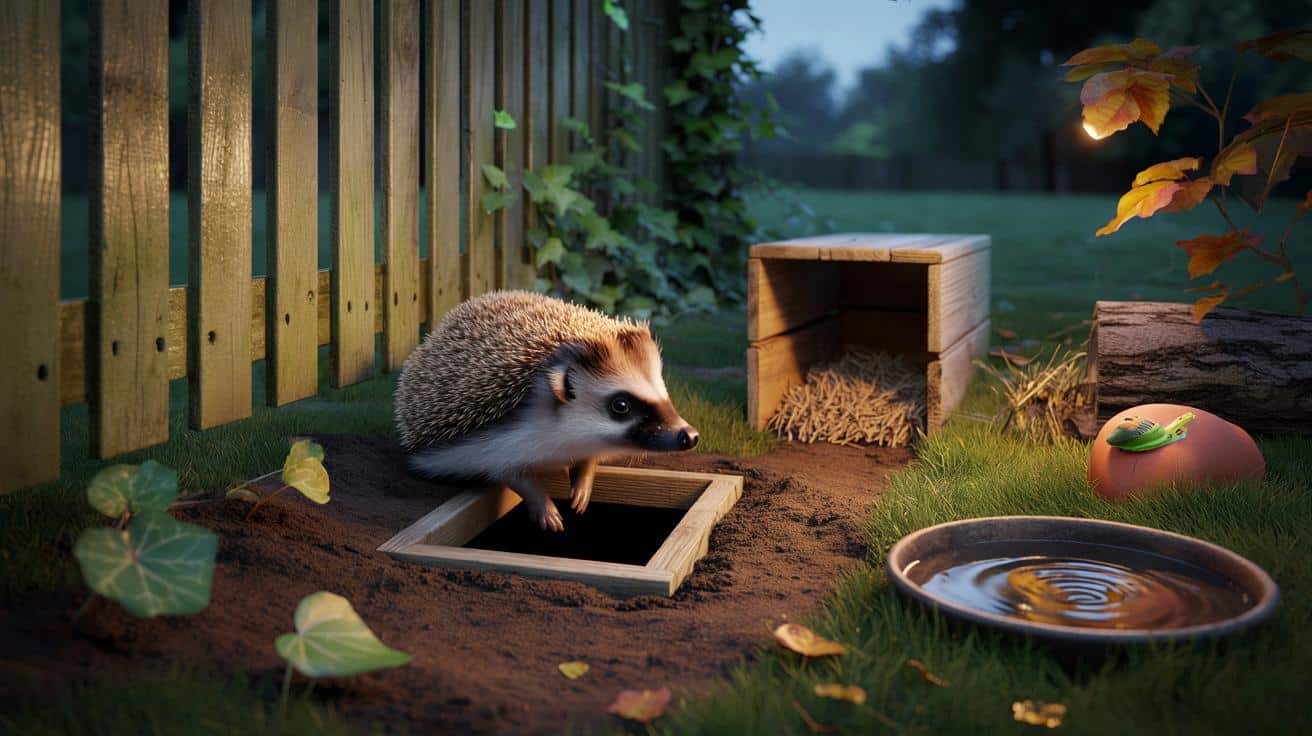The clue is at ground level.
October tips the balance for hedgehogs. They need food, water and safe routes before winter sets in. A small, deliberate change on your boundary can unlock a nightly parade of spiky helpers, while saving your plants from slug damage.
Why october matters for hedgehogs
Hedgehogs spend October building fat reserves and scouting for secure winter quarters. They often hibernate from November to March, depending on weather and food availability. They roam widely in a single night, so a blocked garden acts like a wall in a maze, wasting precious energy.
Researchers report serious rural declines over two decades, while towns show signs of stabilising. Your patch can make a measurable difference. Open access, clean water and messy corners give hedgehogs a fighting chance.
Hedgehogs often travel close to one mile per night. A single small gap can connect several gardens and multiply safe foraging space.
The one change you can make today
Create a hedgehog highway in your fence or gate
Cut a ground-level opening so hedgehogs can pass between plots. You don’t need a new gate or costly kit. A hand saw and a steady approach will do.
| Detail | Recommended |
|---|---|
| Opening size | 13cm x 13cm (about 5in x 5in) |
| Height from ground | Flush at soil level |
| Time | 30–45 minutes for one hole |
| Typical cost | £0–£10 if DIY |
| Where | Base of a fence panel or under a solid gate |
Screw on a simple “hedgehog highway” cover plate if you want a neat finish and to discourage enlarging by pets. Speak to neighbours and line up holes that roughly match. A chain of three or four gardens creates a safe corridor without disturbing anyone’s privacy.
Think of it as a night-time shortcut. You give hedgehogs access to food and shelter; they return the favour by eating slugs and snails.
Food, water and a place to lie low
Feed safely, water smartly
- Offer a shallow dish of fresh water every evening. Refresh daily.
- Use meaty cat or dog food, or purpose-made hedgehog biscuits. Small portions reduce waste and pests.
- Never put out milk or bread. Milk upsets hedgehogs’ stomachs and can cause dehydration.
- Place food under a shelter (an upturned box with a 13cm entrance) to deter cats and foxes.
Build cover they actually use
Create a shaded refuge. A log pile, leaf heap or a purpose-built hedgehog house gives protection from cold snaps and predators. Aim for a quiet corner away from frequent footfall and pet routes. A simple board leaned against a wall can form a dry, windproof nook, particularly useful in wet spells.
Mix materials for structure and warmth: sticks for a frame, dry leaves for insulation, and a handful of hay for bedding. Avoid plastic bags or netting, which can trap or injure wildlife.
Make a wild corner work for you
Set aside a patch where you let nature take the lead. Hedgehogs hunt through long grass and leaf litter for beetles, worms and caterpillars. That reduces pressure on vegetable beds and tender perennials.
- Let a metre-square corner go untidy with leaves, twigs and hollow stems.
- Stack a small heap of rotting logs to feed insects, which then feed hedgehogs.
- Leave access behind sheds and along boundaries; avoid sealing gaps with gravel boards.
Common mistakes to avoid in october
Bonfire risks and garden clean-ups
Bonfire Night lands just as hedgehogs look for dry, dense piles to sleep in. That tempting wood stack in late October often becomes a ready-made shelter. Always rebuild bonfires on the day you light them and check leaf piles before moving or burning them.
- Lift piles gently with a fork and inspect with a torch before lighting.
- Keep dogs away while you check; a startled hedgehog rolls into a ball and can be hard to spot.
- Delay major hedge cutting until spring to protect hibernation sites.
Chemicals that undo your good work
Avoid slug pellets and broad-spectrum pesticides. Poisoned slugs can harm hedgehogs and birds. Try beer traps, hand-picking at dusk, copper bands on pots, and wool pellets around prized plants. Healthy soil and predators such as frogs, birds and hedgehogs create a balanced system that cuts down on slug surges.
What if you have a small dog or curious cat
If you worry about pets escaping through a gap, set the opening at the far end of a border and screen it with a short “tunnel” made from a 13cm-wide pipe or a narrow passage between two bricks. Most dogs cannot squeeze through. Keep feeding stations under a cover so cats don’t monopolise the food.
How to tell your highway works
Hedgehogs leave black, shiny droppings full of beetle shells. You may spot faint tracks in soft soil or dew-disturbed trails in the morning. Cameras often capture them from 10pm to 3am on mild nights. If food vanishes but you never see a hog, scatter a little play sand by the dish and check for tiny, five-toed prints.
Neighbour power and quick wins
One hole is good, three are better
Most urban hedgehogs use several gardens across a night. Two or three aligned gaps can unlock a whole street’s worth of foraging. A polite note through the door with a sketch and measurements often wins support. Offer to do the cutting and tidy up.
Link three gardens and you add hundreds of square metres of safe feeding ground before winter. That can carry a hedgehog through to spring.
Extra tips for a resilient autumn garden
- Plant late-flowering nectar sources like ivy to support insects, which in turn feed hedgehogs.
- Mulch beds with compost. Moist soil hosts more worms and beetles, especially during mild spells.
- Keep a low, shallow ramp in ponds so hedgehogs can climb out if they fall in.
- Secure netting at least 30cm above ground to prevent entanglement.
If you only have 30 minutes this weekend
Cut a 13cm x 13cm gap in your fence. Put out a shallow water dish. Rake leaves into a quiet corner and top with a few sticks. Place a shoe-box-sized shelter over a spoonful of meaty cat food. You will have created access, hydration and shelter in under an hour for less than a tenner.
Helpful context to guide your choices
Britain’s hedgehog is classed as vulnerable on the national Red List, with steep rural declines since 2000. Urban populations depend heavily on small garden decisions. A connected street can function like a single, well-managed park, even where individual gardens are tiny. If you rent, ask your landlord before cutting a fence and check for buried services near posts.
If you want to go further, map a mini green network on your road. Mark likely routes, agree on gap locations and share the workload. Add a couple of wildlife-friendly lights at low brightness to keep paths safe for you without blasting the borders. The more you link, the more hedgehogs can travel, feed and settle before the first hard frost arrives.









Just cut a 13cm x 13cm hole this afternoon—took 35 mins with a handsaw. Already spotted tiny prints by the water dish. Thanks for the clear steps! 😊
Isn’t 13cm too big? I’m worried about rats or my small terrier squeezing through. Any data on unwanted visitors vs hedgehog benefits, or ways to screen the gap without blocking hogs?